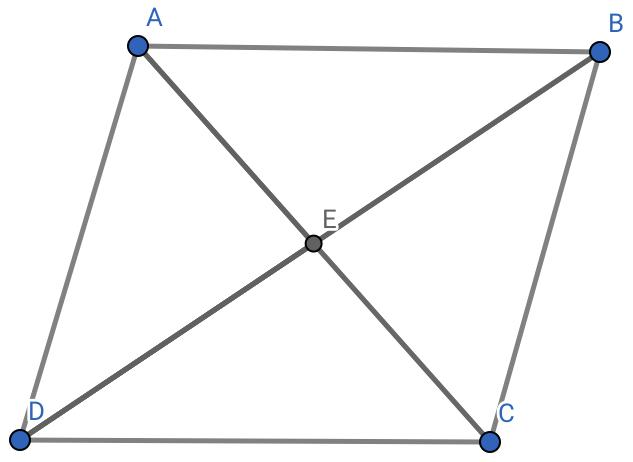
The diagonals of a rhombus bisect each other at ________angles.
A. Acute
B. Obtuse
C. Right
D. None
Answer
516.3k+ views
Hint: In this question is given that we have to find at what angles the diagonals of a rhombus bisects each other, so to find the solution first of all we need to draw a rhombus ABCD where AC and BD are the diagonals which interests each other at E.

For a rhombus AE=EC and BE=ED.
Complete step-by-step answer:
We know that the diagonals of a parallelogram bisect each other.
Also we know that every rhombus is a parallelogram, but the main difference is every side of a rhombus is equal, i.e, AB=BC=CD=DA.
Now for
CD=CB [Sides of a rhombus]
BE=ED [ since, diagonals bisects each other]
CE=CE [ common side]
So by SSS congruence (side-side-side) property, we can say that,
i.e,
As we know that ‘CPCT rule: if two or more triangles are congruent, then all of their corresponding angles and sides are congruent’
So by CPCT we can say that,
Since
i.e,
Now by equation (1) we can write,
Hence, the diagonals of a rhombus bisect each other at right angles.
So the correct option id option C.
Note: So to solve this type of problem you need to know that a rhombus is also a parallelogram but for a rhombus the corresponding sides are equal to each other, and also diagonals of a rhombus perpendicularly bisects each other.

For a rhombus AE=EC and BE=ED.
Complete step-by-step answer:
We know that the diagonals of a parallelogram bisect each other.
Also we know that every rhombus is a parallelogram, but the main difference is every side of a rhombus is equal, i.e, AB=BC=CD=DA.
Now for
CD=CB [Sides of a rhombus]
BE=ED [ since, diagonals bisects each other]
CE=CE [ common side]
So by SSS congruence (side-side-side) property, we can say that,
i.e,
As we know that ‘CPCT rule: if two or more triangles are congruent, then all of their corresponding angles and sides are congruent’
So by CPCT we can say that,
Since
i.e,
Now by equation (1) we can write,
Hence, the diagonals of a rhombus bisect each other at right angles.
So the correct option id option C.
Note: So to solve this type of problem you need to know that a rhombus is also a parallelogram but for a rhombus the corresponding sides are equal to each other, and also diagonals of a rhombus perpendicularly bisects each other.
Latest Vedantu courses for you
Grade 10 | MAHARASHTRABOARD | SCHOOL | English
Vedantu 10 Maharashtra Pro Lite (2025-26)
School Full course for MAHARASHTRABOARD students
₹33,300 per year
Recently Updated Pages
Master Class 9 General Knowledge: Engaging Questions & Answers for Success

Master Class 9 English: Engaging Questions & Answers for Success

Master Class 9 Science: Engaging Questions & Answers for Success

Master Class 9 Social Science: Engaging Questions & Answers for Success

Master Class 9 Maths: Engaging Questions & Answers for Success

Class 9 Question and Answer - Your Ultimate Solutions Guide

Trending doubts
Where did Netaji set up the INA headquarters A Yangon class 10 social studies CBSE

A boat goes 24 km upstream and 28 km downstream in class 10 maths CBSE

Why is there a time difference of about 5 hours between class 10 social science CBSE

The British separated Burma Myanmar from India in 1935 class 10 social science CBSE

The Equation xxx + 2 is Satisfied when x is Equal to Class 10 Maths

What are the public facilities provided by the government? Also explain each facility




